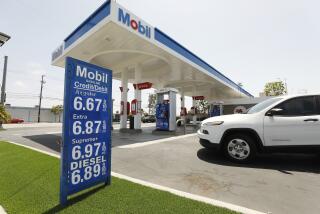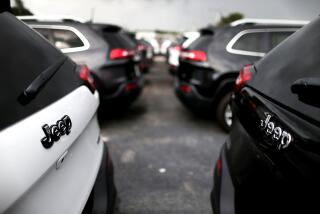Railroad industry urges upgrade in oil tank car safety
After a series of fiery crashes involving trains hauling crude oil, the railroad industry called on the federal government Thursday to significantly strengthen safety standards for new tank cars and require retrofitting of the nation’s huge fleet of existing tankers.
Tank car safety has taken on greater urgency as the oil industry turns to rail to ship the massive increases in oil production that are occurring in shale fields not served by major pipelines, including North Dakota, Colorado and south Texas.
U.S. crude production is up 41% since 2006, but efforts to build new pipelines have been resisted by either the refinery industry or environmentalists, increasingly leaving oil producers to rely on rail. Trains can carry 100 or more tank cars, each containing about 30,000 gallons of crude — about as much as a large residential swimming pool. In some cases, the crude can be nearly as flammable as gasoline.
The inherent risk of the evolving transportation system became apparent in July when an unattended train with 72 tank cars rolled downhill and crashed in the Canadian town of Lac-Megantic, Quebec, killing at least 42 people. Since then, at least two crude-oil trains in the U.S. have derailed.
The crashes led the federal Pipeline and Hazardous Material Safety Administration to take an initial step to tighten safety standards on tank cars, calling on the public to file comments on the matter.
On Thursday, the Assn. of American Railroads filed comments in that rule-making process and called for a number of tank car improvements.
“We believe it’s time for a thorough review of the U.S. tank car fleet that moves flammable liquids, particularly considering the recent increase in crude oil traffic,” said association President Edward R. Hamberger. “Our goal is to ensure that what we move, and how we move it, is done as safely as possible.”
Tank cars are owned by leasing firms, finance companies and oil producers, not railroads. But railroads typically share the blame for crashes.
The association asked federal regulators to require an outer steel jacket around tank cars, thermal protection, shields at the front and back, and pressure relief valves. It also asked that older-model tank cars be “aggressively” phased out, unless they are retrofitted to meet the new federal requirements. In addition, the association wants to eliminate a potential loophole that allows oil producers to label certain thick crudes as “combustible” rather than “flammable.”
The association did not propose a timetable, spokeswoman Holly Arthur said.
The comments echo what the association has been asking federal regulators since 2011, as it became apparent that a major surge in crude shipments was occurring. Railroads hauled 25 times more tank cars in 2012 than they did in 2008, and the volume is continuing to rise this year.
The nation’s tank car fleet includes 92,000 that haul flammable liquids. Under the association’s proposal, 78,000 of them would have to be upgraded or phased out.
Arthur said the association had no estimate of how much the proposed safety measures would cost.
The Railway Supply Institute, which represents tank car owners, has not yet responded to the proposal, and officials declined to respond to requests for comment.
More to Read
Sign up for Essential California
The most important California stories and recommendations in your inbox every morning.
You may occasionally receive promotional content from the Los Angeles Times.











